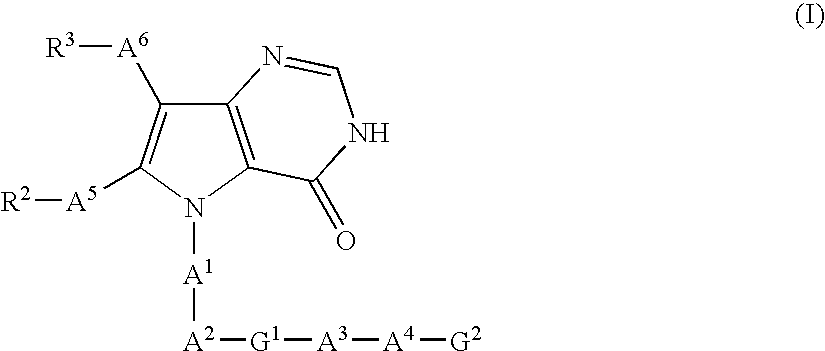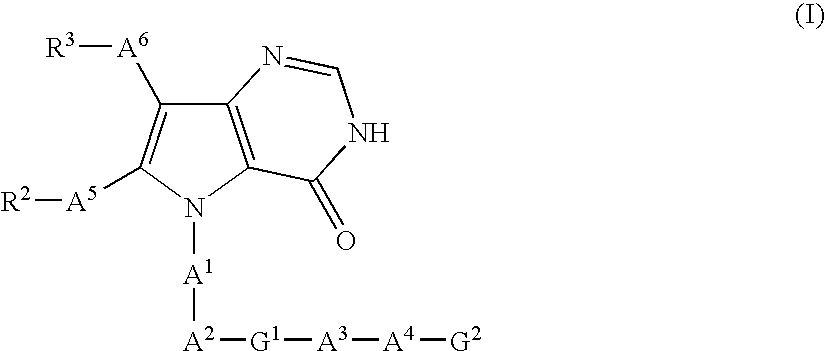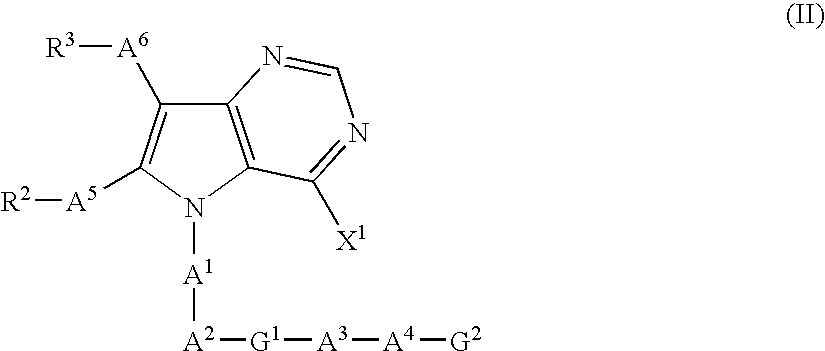Pyrrolopyrimidinone derivatives
a technology of pyrrolopyrimidinone and derivatives, which is applied in the field of new pyrrolopyrimidinone derivatives, can solve the problems of strict control of blood glucose levels, inability to reproduce normal cells, and liable to induce diabetic complications,
- Summary
- Abstract
- Description
- Claims
- Application Information
AI Technical Summary
Benefits of technology
Problems solved by technology
Method used
Image
Examples
reference example 1
Synthesis of (cyclopropylhydroxy-methylene)methane-1,1-dicarbonitrile
[0456]
[0457] A tetrahydrofuran (150 mL) suspension of sodium hydride (11.49 g) was cooled to 0° C. To the cooled suspension was added dropwise a tetrahydrofuran (50 mL) solution of malononitrile (15.8 g) over an hour. The reaction mixture was stirred at room temperature for 1 hour and cooled to 0° C. To the reaction mixture was added dropwise over 80 minutes a tetrahydrofuran (50 mL) solution of cyclopropylcarbonyl chloride (25.0 g). The reaction mixture was stirred at room temperature for 49 hours, followed by adding water (50 mL) to the reaction solution. The solvent was distilled off under reduced pressure. To the residue were added ethyl acetate (200 mL) and hydrochloric acid (270 mL, 1 mol / L), which was extracted with ethyl acetate. The organic layer was washed with saturated brine and dried over anhydrous sodium sulfate, and then the solvent was distilled off under reduced pressure to obtain a crude product ...
reference example 2
Synthesis of (cyclopropylmethoxy-methylene)methane-1,1-dicarbonitrile
[0462]
[0463] A tetrahydrofuran (100 mL) suspension of sodium hydride (2.6 g) was cooled to 0° C. To the cooled suspension was added dropwise a tetrahydrofuran (60 mL) solution of crude (1-hydroxy-2-phenylmethylidene)methane-1,1-dicarbonitrile (14.5 g) over 30 minutes. The reaction mixture was stirred at room temperature for 20 minutes and cooled to 0° C. To the reaction mixture was added dropwise a tetrahydrofuran solution (40 mL) of dimethyl sulfate (13.7 g) over 1 hour. After heating for 21 hours to reflux, the reaction mixture was cooled to room temperature, and the solvent was distilled off under reduced pressure. To the residue were added ethyl acetate (100 mL) and saturated sodium hydrogen carbonate solution (100 mL), and extraction with ethyl acetate was performed. The organic layer was washed with saturated brine and dried over anhydrous sodium sulfate, and then the solvent was distilled off under reduced ...
reference example 3
Synthesis of methyl 3-amino-1-{2-[(t-butoxy)carbonylamino]ethyl}-4-cyano-5-cyclopropylpyrrole-2-carboxylate
[0465]
[0466] To an acetonitrile (150 mL) solution of (methoxycyclopropylmethylene)methane-1,1-dicarbonitrile (8.7 g) was added N-(2-aminoethyl) t-butyl carbaminic acid (16.3 g) and stirred at room temperature for 10 minutes. To the resultant product were added anhydrous cesium carbonate (38.5 g) and methyl bromoaccetate (11.2 mL), followed by heating for 6 hours to reflux. The reaction product was cooled to room temperature and allowed to stand. Then, the supernatant was separated by decantation and the solvent was distilled off under reduced pressure. The concentrated residue and a solid remaining after decantation were collected and ethyl acetate and water were added thereto, followed by extracting 3 times with ethyl acetate. The organic phase was washed with water and saturated brine, and dried over anhydrous magnesium sulfate. After magnesium sulfate was removed by filtrat...
PUM
 Login to View More
Login to View More Abstract
Description
Claims
Application Information
 Login to View More
Login to View More - R&D
- Intellectual Property
- Life Sciences
- Materials
- Tech Scout
- Unparalleled Data Quality
- Higher Quality Content
- 60% Fewer Hallucinations
Browse by: Latest US Patents, China's latest patents, Technical Efficacy Thesaurus, Application Domain, Technology Topic, Popular Technical Reports.
© 2025 PatSnap. All rights reserved.Legal|Privacy policy|Modern Slavery Act Transparency Statement|Sitemap|About US| Contact US: help@patsnap.com



